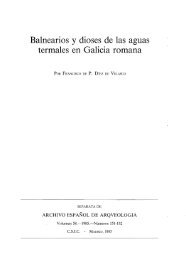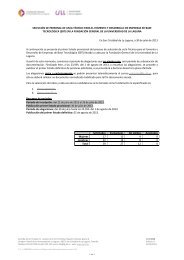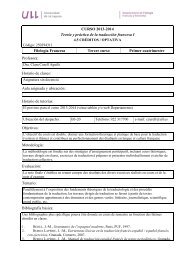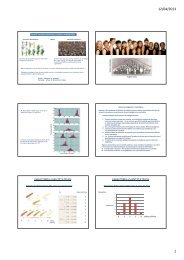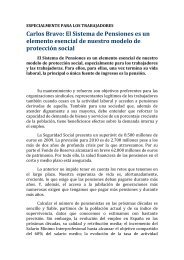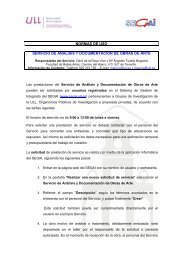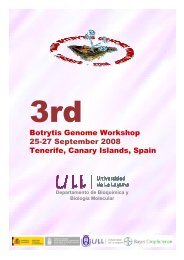BIS/BAS individual differences and the verification of conditional ...
BIS/BAS individual differences and the verification of conditional ...
BIS/BAS individual differences and the verification of conditional ...
You also want an ePaper? Increase the reach of your titles
YUMPU automatically turns print PDFs into web optimized ePapers that Google loves.
300 H. Marrero et al. / Personality <strong>and</strong> Individual Differences 45 (2008) 296–301contrast in Fig. 3 that only <strong>the</strong> group <strong>BAS</strong>(+)/<strong>BIS</strong>(+) has visiblychanged among <strong>the</strong> two conditions.In this group <strong>the</strong>re are more appetitive responses (gain cardselection) in <strong>the</strong> large gain/small loss condition (47%) than in smallgain/large loss condition (8%), although this difference did notreach significance, p = 0.26.4. General discussionIn accordance with RST predictions, our results have shown thatchanges in <strong>the</strong> values <strong>of</strong> reward <strong>and</strong> punishment in interactionwith <strong>individual</strong> variability in sensitivity to reward <strong>and</strong> punishmentinduced ei<strong>the</strong>r <strong>verification</strong> or falsification in <strong>the</strong> game task. Alsorelevant, <strong>the</strong> greater percentage <strong>of</strong> appetitive (verifying) responses– selecting <strong>the</strong> gain – was given by <strong>individual</strong>s high in <strong>BAS</strong> but lowin <strong>BIS</strong>. Conversely, <strong>the</strong> greater percentage <strong>of</strong> aversive (falsifying)responses – selecting <strong>the</strong> loss – was given by <strong>individual</strong>s high in<strong>BIS</strong> but low in <strong>BAS</strong>. In addition, our results have indicated thatwhen <strong>the</strong> value <strong>of</strong> <strong>the</strong> loss (punishment) is high, <strong>BIS</strong> inhibits impulsivitytowards selecting <strong>the</strong> gain card (reward) in high <strong>BAS</strong> participants.This pattern <strong>of</strong> results supports <strong>the</strong> joint subsystemshypo<strong>the</strong>sis (Corr, 2002).Our results also indicate that <strong>the</strong> functional distinction betweenanxiety <strong>and</strong> fear is appropriate to examine <strong>the</strong> role <strong>of</strong> <strong>individual</strong><strong>differences</strong> in punishment sensitivity in selection behaviour. Inour game task <strong>the</strong>re was an approach–avoidance conflict <strong>of</strong> attaining<strong>the</strong> reward (<strong>the</strong> gain) <strong>and</strong> avoiding <strong>the</strong> punishment (<strong>the</strong> loss).In this context, participants high in fearfulness to potential punishmentwill experience <strong>the</strong> task in <strong>the</strong> small gain/large loss conditionas <strong>the</strong> origin <strong>of</strong> an approach–avoidance conflict, <strong>and</strong> motivated by<strong>BIS</strong>, will tend to inspect <strong>the</strong> loss card (<strong>the</strong> risk <strong>of</strong> loss). In contrast,participants low in fearfulness (in <strong>the</strong> pursuit <strong>of</strong> a reward) willtend to ignore punishment, <strong>and</strong> to minimize this conflict. As a result,<strong>BIS</strong> is not triggered <strong>and</strong> <strong>BAS</strong> would lead <strong>the</strong>m to select <strong>the</strong> gaincard (reward).In this light, we consider that fur<strong>the</strong>r research is necessary toexamine <strong>the</strong> role <strong>of</strong> fearfulness in <strong>individual</strong> <strong>differences</strong> in reward<strong>and</strong> punishment sensitivities in <strong>the</strong> light <strong>of</strong> <strong>the</strong> revised RST. Moregenerally, a more precise definition <strong>and</strong> measurement <strong>of</strong> <strong>the</strong> psychologicalstructure <strong>of</strong> <strong>the</strong>se sensitivities is needed (see Caseraset al., 2003).Overall, our results uphold <strong>the</strong> relevance <strong>of</strong> <strong>the</strong> revised RST(Gray & McNaughton, 2000) in <strong>the</strong> examination <strong>of</strong> <strong>individual</strong> <strong>differences</strong>in reward/punishment sensitivities in reasoning, particularlyin <strong>the</strong> process <strong>of</strong> <strong>verification</strong>/falsification <strong>of</strong> hypo<strong>the</strong>ticalaction ? result <strong>conditional</strong>s. Also relevant is <strong>the</strong> fact that our resultssupport in human behaviour several RST proposals that havebeen previously tested in animal research. In this context, <strong>the</strong>ymake a contribution to <strong>the</strong> research program aimed at showing<strong>the</strong> usefulness <strong>of</strong> <strong>BIS</strong>/<strong>BAS</strong> systems as organizing <strong>the</strong>mes for <strong>the</strong>orydevelopment. Reward <strong>and</strong> punishment sensitivities could constitutea bridge between disparate psychological ambits such as motivation<strong>and</strong> personality on <strong>the</strong> one h<strong>and</strong> <strong>and</strong> reasoning <strong>and</strong>decision-making about actions in social contexts, on <strong>the</strong> o<strong>the</strong>r.Our research has also combined experimental <strong>and</strong> correlationalmethodologies. The relevance <strong>of</strong> relating <strong>the</strong>se for <strong>the</strong> progress <strong>of</strong>scientific psychology was pointed out by Cronbach (1957) decadesago.AcknowledgementsWe are specially grateful for <strong>the</strong> advice <strong>of</strong> Margaret Gillon <strong>and</strong>Philip Corr. Thanks also to two anonymous reviewers who <strong>of</strong>feredvaluable criticisms <strong>and</strong> suggestions.Appendix ASuppose that you go to a casino. When you go in, you find a newcard game. The game is about turning up cards to check certainrules. The cards have letters on one side, <strong>and</strong> a result on <strong>the</strong> o<strong>the</strong>rside: ei<strong>the</strong>r 1 € [100 €] gain or 100 € [1 €] loss.Below, <strong>the</strong>re are four cards <strong>the</strong> same as those displayed in <strong>the</strong>game:CARD DISPLAYAs you can see, two cards show <strong>the</strong> letter side (<strong>and</strong> <strong>the</strong> resultside is hidden) <strong>and</strong> two cards show <strong>the</strong> result side (<strong>and</strong> <strong>the</strong> letterside is hidden). The rule that you have to check on this occasionis: Whenever a card has a letter A on one side, <strong>the</strong>n <strong>the</strong> card has ‘‘1€ gain” [100 €] on <strong>the</strong> o<strong>the</strong>r side. As you can imagine, <strong>the</strong> card with<strong>the</strong> letter A could have on <strong>the</strong> o<strong>the</strong>r side ei<strong>the</strong>r ‘‘1 € [100 €] gain” or‘‘100 € [1 €] Loss”. Therefore, if <strong>the</strong> rule is true <strong>the</strong>n you will gain 1 €[100 €], <strong>and</strong> if it is false you will lose 1 € [100 €]. Let us suppose thatbefore <strong>the</strong> game starts (<strong>and</strong> before you gain or lose money), you aregiven <strong>the</strong> opportunity to carry out a previous test. Logically, thistest has to evaluate whe<strong>the</strong>r this rule: Whenever a card has a letterA on one side <strong>the</strong>n <strong>the</strong> card has ‘‘1 € gain” [100 €] on <strong>the</strong> o<strong>the</strong>r side isFALSE. The cards displayed above are to carry out this test. Once<strong>the</strong> test has been carried out, <strong>the</strong> game will start with <strong>the</strong> display<strong>of</strong> similar cards. If you check that <strong>the</strong> rule is false, <strong>the</strong>n you can‘‘pass” when it’s your turn <strong>and</strong> so avoid losing 100 € [1€].To do <strong>the</strong> test you have to indicate those two cards you definitelyneed to turn over to evaluate that <strong>the</strong> rule is false.I’ll turn over <strong>the</strong> cards:Explain briefly <strong>the</strong> reasons for your selection:A.1. Card displayA.1.1. Small gain/large loss versionA Y 1gain100loss1 2 3 4A.1.2. Large gain/small loss versionReferencesA Y 100gain1loss1 2 3 4Carver, Ch. S. (2006). Approach, avoidance, <strong>and</strong> <strong>the</strong> self-regulation <strong>of</strong> affect <strong>and</strong>action. Motivation <strong>and</strong> Emotion, 30, 105–110.Carver, Ch. S., & White, T. L. (1994). Behavioral activation <strong>and</strong> affective responses toimpending reward <strong>and</strong> punishment: The <strong>BIS</strong>/<strong>BAS</strong> scales. Journal <strong>of</strong> Personality<strong>and</strong> Social Psychology, 67(2), 319–333.Caseras, X., Ávila, C., & Torrubia, R. (2003). The measurement <strong>of</strong> <strong>individual</strong><strong>differences</strong> in behavioural inhibition <strong>and</strong> behavioural activating systems: Acomparison <strong>of</strong> personality scales. Personality <strong>and</strong> Individual Differences, 34,999–1013.Corr, P. J. (2002). J.A. Gray’s reinforcement sensitivity <strong>the</strong>ory: Tests <strong>of</strong> <strong>the</strong> jointsubsystems hypo<strong>the</strong>sis <strong>of</strong> anxiety <strong>and</strong> impulsivity. Personality <strong>and</strong> IndividualDifferences, 33, 511–532.Corr, P. J. (2004). Reinforcement sensitivity <strong>the</strong>ory <strong>and</strong> personality. Neuroscience &Biobehavioral Reviews, 28, 317–332.




